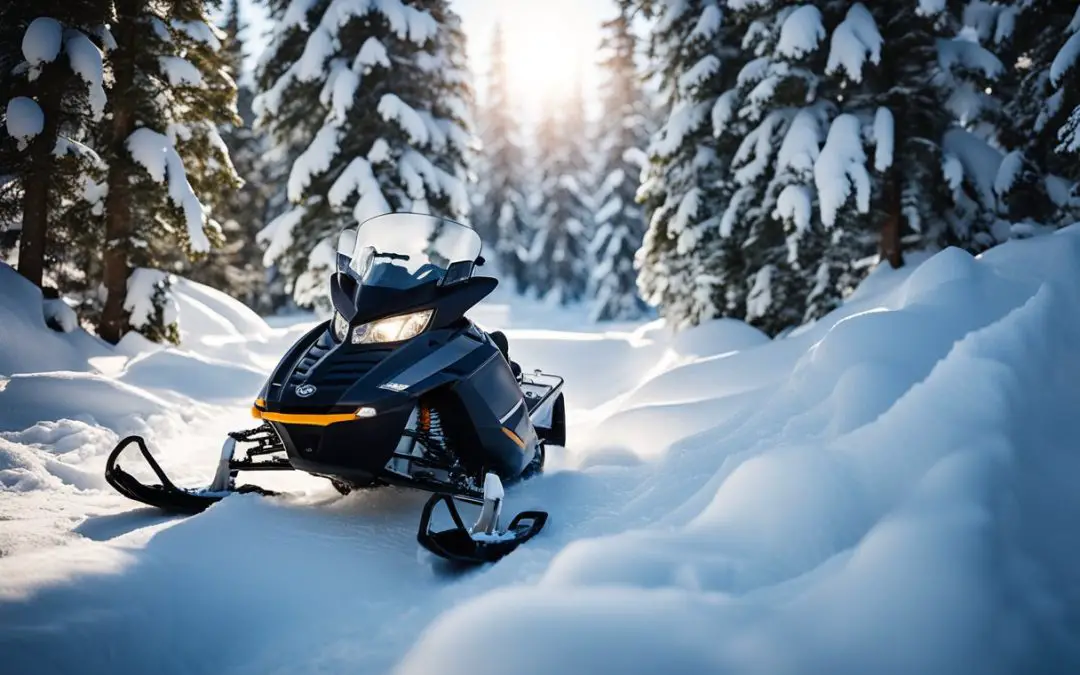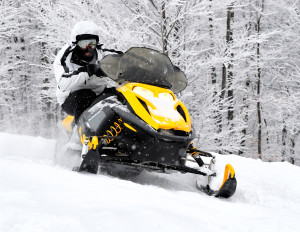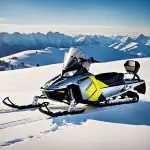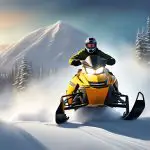Venturing out on a crisp, winter day for a ride through freshly-fallen snow is a thrill many snowmobile enthusiasts eagerly anticipate. But before you strap on your helmet and start your engine, it's critical to ensure there's enough snow to support your adventure. Riding a snowmobile requires a sufficient snow base not only for optimal performance but also to prevent damage to both the machine and the terrain.
Minimum Snow Requirements
When planning a snowmobile excursion, knowing the minimum snowfall needed ensures a safe and enjoyable ride.
You'll generally need a base layer of 6 inches of snow to snowmobile. This amount supports your snowmobile and provides enough cushion between the machine and the ground. For lighter snowmobiles, 4 to 5 inches of snow might suffice, but heavier machines definitely require 6 inches or more for an optimal experience. It's worth noting that most enthusiasts prefer riding with more than the minimum, to enhance safety and performance.
Understanding how much snow is needed to safely and responsibly snowmobile is a fundamental aspect of the sport. The depth of the snow can affect everything from the type and condition of the equipment you use to the techniques you employ while riding. Moreover, varying snow conditions may require different approaches to snowmobiling, emphasizing the need for preparation and awareness each time you head out.

Factors Influencing Snow Amounts Needed
Various elements can alter the minimum amount of snow you need:
- Snowmobile Type: Lighter models can manage with 4 inches, while heavier ones need 6 to 7 inches.
- Terrain: Open fields may need less, whereas rocky or wooded areas require more snow for protection against underlying obstacles.
Always consult with local snowmobile clubs or check the area's guidelines you plan to ride in, as trail conditions can demand different snow depths for a safe and enjoyable experience.
The right knowledge can make your adventure both safe and exhilarating.
Snow Conditions and Quality
To enjoy snowmobiling, the snow on the ground must be just right. Not all snow is created equal, and different types can significantly affect your ride.
Types of Snow and Their Impact on Snowmobiling
- Fresh Snow: This is what you might call 'powdery' snow. It's light, fluffy, and can provide a smooth ride. However, it may not be as stable as other types.
- Packed Snow: Over time, snow becomes more compact. Packed snow is ideal for snowmobiling, as it provides a firm surface with good traction.
- Wet Snow: You'll find this type of snow when temperatures are slightly above freezing. It can be more challenging to ride on because it's heavier and stickier.
- Powdery Snow: Similar to fresh snow but even lighter and drier. It can create a cloud of snow dust when riding and may reduce visibility.
- Hard Snow: This occurs when the temperature drops and the snow freezes. It can be slippery and tough on your snowmobile's skis and tracks.
- Heavy Snow: Thick and dense, heavy snow requires more power to traverse and can be demanding on both the snowmobile and the rider.
Understanding Snow Density and Terrain
The density of the snow is connected to how heavy or light it feels:
- Light, low-density snow 1, like fresh or powdery snow, means you'll cruise with less resistance but need to be cautious of hidden obstacles.
- High-density snow, such as hard or wet snow, requires more effort to maneuver through but provides more stability.
Snow Density and Impact Chart:
| Snow Type | Density | Description | Impact on Snowmobiling |
|---|---|---|---|
| Fresh Snow | Light | Fluffy, new snowfall | Easy to disturb, hides obstacles |
| Packed Snow | Medium to High | Compacted over time | Ideal for traction and stability |
| Wet Snow | High | Moist and heavy | Sticky and can bog down the machine |
| Powdery Snow | Very Light | Dry and fine granular snow | Could cause visibility issues |
| Hard Snow | High | Freezes solid | Slippery, wear on equipment |
| Heavy Snow | High | Dense and abundant | Requires more power to ride |
Remember, whichever snow type you encounter, always know your limits and ride within them to ensure your safety and enjoyment on the trails.
Equipment and Preparation for Low Snow Conditions
When you're planning to ride in low snow conditions, choosing an appropriate snowmobile and gearing up with protective wear are critical steps to ensure both pleasure and protection.
Choosing the Right Snowmobile for Conditions
In scenarios with less snow, it’s important to select a lighter snowmobile to prevent getting stuck in the snow. Lighter models are designed to distribute weight more evenly, decreasing the likelihood of sinking into the sparse snowpack. Check for models with higher clearance and efficient tread patterns that enhance grip and mobility when you ride your sled without the cushion of deep snow.
Protective Gear and Precautions
Protective gear is essential when you ride to minimize the risk of injury and to safeguard against the harsh elements:
- Helmet: Always wear a DOT-approved helmet. Opt for one with a visor to protect your face from wind and debris.
- Goggles: Equip yourself with anti-fog goggles to maintain clear vision.
- Jacket & Pants: Wear insulated, water-resistant outerwear to keep warm and dry.
- Gloves: Pick gloves that offer both warmth and dexterity.
- Boots: Insulated, waterproof boots are a must-have for warmth and stability.
In addition to wearing the right gear, be sure to inspect your snowmobile to avoid any potential damage. Adequate preparation reduces the risk to both you and your machine, ensuring that fun doesn't come at the expense of safety or the longevity of your snowmobile.
Techniques for Snowmobiling in Varying Depths
When you're heading out into the snow on your snowmobile, being prepared for different snow conditions is key. In various snow depths, you'll need to adapt your riding techniques to stay safe and enjoy your ride.
Riding in Light Snow
Light snow conditions, typically around 6 inches of snow, require careful handling to prevent your snowmobile from bottoming out. When the snow depth is minimal, it’s essential to:
- Maintain a higher speed to stay on top of the snow and prevent sinking in.
- Use a lighter touch on the throttle to avoid spinning out.
- Choose your path wisely, avoiding rocks and obstacles that could be hidden just below the snow surface.
Areas with a snow depth just at or slightly above six inches can still provide an enjoyable ride, but always ensure you're aware of the terrain underneath to prevent damage to your sled or a potential accident.
Handling Deep Snow and Icy Conditions
When dealing with deeper snow or icy patches, your approach should change to accommodate these more challenging conditions:
- Lean back to lift the front end and maintain momentum in deep snow.
- For icy conditions, reduce your speed and use gentle, smooth movements.
- Use body weight to help steer the snowmobile; leaning into turns can help navigate through deeper snow.
Remember that in areas with deeper snow, it can be easy for a sled to become stuck, so always ride with caution and be prepared for increased physical exertion to maneuver the snowmobile.
Understanding the Basics of Snowmobiling
Essential Snowmobile Terminology
To fully enjoy your snowmobiling experience, you'll want to familiarize yourself with some key terms:
- Sled: Another term for a snowmobile, it's your vehicle for gliding over the snow.
- Track: The rear portion of the snowmobile that makes contact with the snow, providing traction.
- Skis: Located at the front of the sled, these help you steer through the snow.
Understanding these basics puts you in the right mindset to further explore and enjoy snowmobiling. When you're ready to ride a snowmobile, remember that
Maintaining Your Snowmobile
Maintaining your snowmobile is essential for ensuring its longevity and optimal performance, especially when considering the varied snow conditions it will encounter. Good maintenance practices can allow you to safely ride a snowmobile in different snow levels and deal with the impact of those conditions on your sled.
Caring for Your Snowmobile in Different Snow Levels
To safely ride a snowmobile, it's important to pay attention to the condition of the snow. Ideally, you need at least 6-7 inches of deep snow to provide enough cushioning for your ride. Less snow can lead to increased wear on your sled's components as you might end up scraping against the ground.
- Hard-packed Snow
- Pre-ride Check: Ensure your skis and track are in good shape to handle the solid terrain.
- Post-ride Care: Remove ice and snow buildup from the skis and tracks to prevent rust and component damage.
- Deep Snow
- Pre-ride Preparation: Confirm that your snowmobile is equipped for deep snow, including proper skis and a track designed for flotation.
- After Riding: Clean out any snow that's packed into the engine bay and undercarriage to maintain proper airflow and prevent moisture-related problems.
Impact of Snow Conditions on Maintenance
Different snow conditions can drastically affect how you should maintain your snowmobile:
- Low Snow Conditions: When you ride your snowmobile without much snow, particularly on patches where grass or dirt is exposed, it's crucial to inspect the bulkhead and tunnel for dents afterward and check the hyfax for excessive wear due to increased friction.
- Wet or Melting Snow: This condition can lead to more moisture in your engine and on various parts of the snowmobile. Ensure that you dry your snowmobile thoroughly after use to prevent rust and corrosion.
Remember, you can ride your snowmobile without snow in certain circumstances, like during grass drag races, but this increases the need for vigilant maintenance to address the additional strain on your machinery. Keep a maintenance schedule and stick to it, no matter the snow conditions to ensure your snowmobile stays in peak condition. 2
Safety Considerations and Best Practices
When you gear up for a snowmobile adventure, ensuring you have enough snow on the ground is just the start. It's equally important to practice safe riding techniques and be well-prepared for emergencies for a truly enjoyable and secure experience.
Safe Riding Techniques
- Know Before You Go: Always check the depth of snow before setting out. Aim for at least 6 inches to ensure you can safely ride a snowmobile without damaging the vehicle or risking injury.
- Understand Your Sled: Each snowmobile handles differently on varying amounts of snow. Lighter sleds may manage on slightly less, while heavier sleds will need a full 6-inch base or more.
- Adapt to the Conditions: Riding techniques must adapt to the depth of the snow. In sparse conditions, avoid aggressive maneuvers to prevent contact with the ground, which can be damaging and unsafe.
Emergency Preparedness and Response
- Carry the Right Gear: Always have a safety kit that includes a first aid kit, a trail map, a compass or GPS, emergency food and water, and a method of starting a fire.
- Learn and Practice: Familiarize yourself with emergency response techniques such as basic first aid and how to signal for help.
Remember, when snowmobiling, your safety is paramount. Whether the snow is enough or if you're pushing the limits with just enough snow on the ground, your awareness and preparation are key to safely enjoying your ride.
Future of Snowmobiling
The excitement around snowmobiling is as much about the ride itself as it is about the dynamic advancements in technology and changes in participation trends. Here's what you need to keep an eye on to stay ahead of the curve.
Advancements in Snowmobile Technology
In recent years, the tech improvements in snowmobiles have been impressive, paving the way for you to enjoy riding with sufficient snow. Manufacturers are now producing models with better fuel efficiency, lower emissions, and enhanced safety features. You'll find snowmobiles tailored to preserve enough snow for your snowmobile, ensuring a lighter touch on delicate terrains. For those keen on deep snow adventure, innovations in track and suspension design provide improved flotation and control.
- Efficiency: Modern engines that are more fuel-efficient and eco-friendly.
- Safety: Enhanced safety features such as improved braking systems and responsive handling.
- Control: Better suspension systems allowing for ability to ride on deep snow with more finesse.
Trends in Snowmobiling Participation
Snowmobiling participation is evolving with a noticeable shift towards a more diverse demographic. There's a growing emphasis on family-friendly experiences and inclusive events that cater to riders of all skill levels. The community is becoming more welcoming, which means regardless of why you're interested in snowmobiling, you'll likely find a group or event that will get you started.
- Diversity: A broader range of participants, including families and riders from different backgrounds.
- Inclusivity: Events and groups aimed at creating a more inclusive snowmobiling culture.
- Education: Increased focus on educating new riders on the importance of maintaining enough snow for your snowmobile and respecting the environment.
Remember, the future of snowmobiling depends as much on these technologies and trends as it does on snow being really accessible and plentiful. Your enjoyment of this sport in the coming years will hinge on how these advancements and shifts in participation enhance your overall experience on the snow.
References:
- https://www.eoas.ubc.ca/courses/atsc113/snow/met_concepts/07-met_concepts/07b-newly-fallen-snow-density/#:~:text=Newly%2Dfallen%20snow%20that%27s%20about,)%2C%20it%27s%20about%208%25.
- https://www.pentictonherald.ca/spare_news/article_846a660b-5584-5b4d-948d-adb1c4bd6b3b.html





